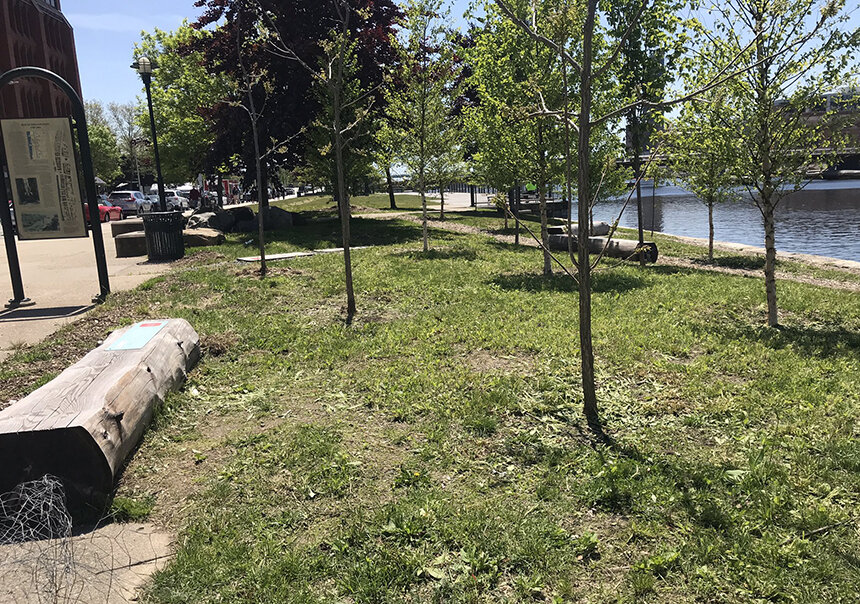Year-Old Urban Meadow Project Vandalized in Providence
May 29, 2020
The coreopsis were “about to pop” when unauthorized landscaping equipment apparently roared onto the banks of the Providence River and mowed down a $15,000 project.
The Living Edge, a landscape project designed by Adam Anderson, was installed last May by Anderson, a local landscape architect, and several volunteers. The founder of Design Under Sky, and the person largely responsible for the field of sunflowers across the river from Davol Square, was awarded the winning proposal in the “Imagine Us Here: Cultivating Public Space for Community Resilience.”
A disappointed Anderson is concerned the meadow’s shearing was vandalism. A spokesperson for the city said the mowing wasn’t done by the Parks Department or a department affiliated with the city or state. She said city officials believe it was an act of vandalism.
“As a Best Management Practice Area that is being cultivated by the arts, the meadow is an integral part of our sustainable parks system,” Patricia Socarras wrote in an email to ecoRI News. “Though we are unaware of who may have mowed the area, our Parks team will work with partners on next steps.”
The project, sponsored by DownCity Design, the Rhode Island Foundation, and the Providence Parks Department, was conceived to “create an enriched place near the edge of the Providence River that brings people together in the face of climate change.”
Last summer, a collection of coneflowers, goldenrod, black-eyed Susans, native grasses, and other pollinator-attracting plants, nestled among 22 newly planted trees, decorated, colorized, and diversified a 10,000-square-foot section of the Providence Riverwalk just north of the Pedestrian Bridge.
“When it blooms, it’s spectacular,” Anderson said. “We had great spring rain, and it was ready to go.”

This native meadow — intended as a tranquil gathering space that reintroduced some of the lost wilderness of the site’s pre-industrial past and designed to help reduce the city’s heat-island effect — was on the verge of blooming when it was hacked down. Anderson believes the mowing happened the Friday before Memorial Day. The birches, swamp white oak, elm trees resistant to Dutch elm disease, and Kentucky coffeetrees weren’t disturbed.
The meadow and trees replaced an eroded lawn that was energy intensive to maintain and made the river’s edge better suited to withstand storm surge, increased precipitation, and erosion. The project entailed removing sod, planting the trees, spreading perennial seeds, and ongoing weeding. The trees were the most expensive aspect of the project, according to Anderson.
He wrote on his website that the idea behind the design was to create “a hybrid of both a culturally and ecologically resilient waterfront, with the intent that this strategy, in conjunction with variations, could be implemented at the city scale to build a unified public realm from downcity to the bay.”
Anderson noted that the project demonstrated the necessity of a coexistence of natural and man-made systems, and highlighted the importance of landscape as a critical component of urban infrastructure.
The Providence resident is cautiously optimistic in the meadow’s long-term recovery. He’s unsure what plants may appear this year. He’s worried spots will open up for weeds to return. He hopes something can be done to keep people from putting down blankets and trampling through the hacked meadow as it attempts to recover. He’s working to create educational signage that would be posted at both the native meadow and the nearby sunflower garden.




Providence has far too much vandalism… it’s disgusting really how much.
How can we help?
I’d like to volunteer to help replant the area or install temporary fencing to keep people out of the area, once something gets approved by the city
Dickheads. We cant have nice things, unfortunately.
I’ve never seen vandals use lawnmowers before and leave trees, benches, and signage perfectly intact. Authorities shouldn’t be too quick to write off bureaucratic mismanagement as a possible cause – perhaps one department or other mowing an adjacent parcel and not informing crews that these plants weren’t ‘weeds’.
I am also willing to help plant, weed or whatever is needed as you bring the meadow back.
I walk by this location daily. I too am available for replanting.
Reseed and install proper signage.
I’ll help too!
I am in adjacent city and want to get rid of my lawn so badly, Looking to find landscaper to remove lawn and natural mulch for eventually designing and planting Natives and making it a protected zone. Seeing this beautiful place about to flower, being mowed down like that made me cry , So Disheartening, Hopefully it will recover. Could have been a management mistake but nobody is going to admit that clearly. But I also know that If I don’t cut my front lawn for 2 weeks(not purposefully just life happens and it rain a weekend so you skip it and during the week you work! and most people with toddlers or babies or kids don’t have any free time, It’s a Pandemic give me a break) I get letters from the town that someone complained and threatening massive fines if the lawn doesn’t get cut. It as been 2 weeks from last time I mowed the front lawn I have pictures and Doorbell Camera Footage. So I really wouldn’t be surprise either that someone would just believe it was a good idea to just go and cut these " ugly weeds".
The plants listed in the article should comeback if the roots were not pulled out… it will take sometime but most will grow back
This is a sad commentary!